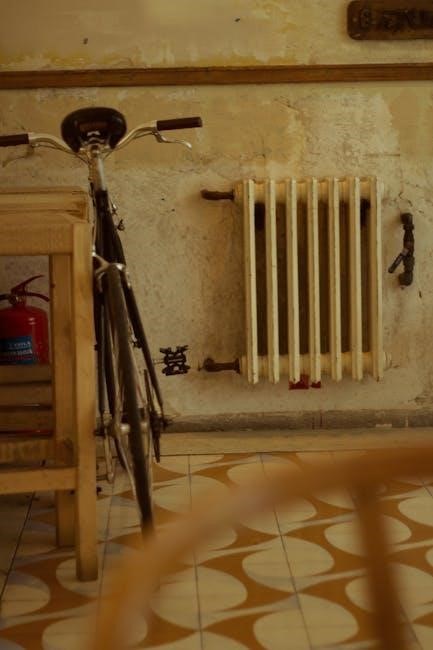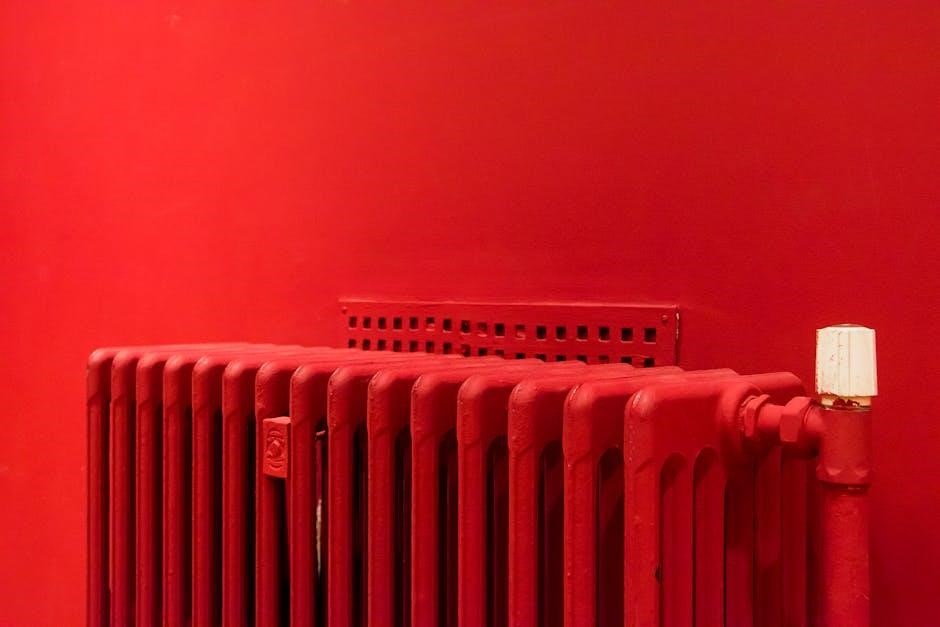Welcome to the Williams Wall Heater manual. This guide provides essential information for safe installation, operation, and maintenance of your Williams Wall Heater. Ensure optimal performance and energy efficiency by following the instructions carefully. Proper installation and regular upkeep are crucial for longevity and safety. Refer to this manual for troubleshooting and technical specifications to maximize your heater’s efficiency and ensure reliable operation.
1.1 Overview of Williams Wall Heaters
Williams Wall Heaters are reliable, energy-efficient heating solutions designed for residential and commercial use. These heaters are known for their durability, safety features, and user-friendly controls. They utilize advanced combustion technology to provide consistent heat while minimizing energy consumption. Available in various models, they cater to different heating needs and are compatible with natural gas or propane. Proper installation and maintenance ensure optimal performance and longevity.
1.2 Importance of the Manual
The manual is essential for safely installing, operating, and maintaining your Williams Wall Heater. It contains vital information on proper usage, installation steps, and maintenance routines. Following the manual ensures compliance with safety standards and manufacturer recommendations, reducing accident risks and extending the heater’s lifespan. It also provides troubleshooting guidance to address common issues effectively.
Safety Precautions
Always follow safety guidelines for proper installation, operation, and maintenance. Handle gas safely, ensure proper ventilation, and maintain required clearances. Avoid storing flammable materials nearby and verify the heater is suitable for the gas type being used to prevent hazards.
2.1 Handling Gas Safely
Always ensure the heater is compatible with the type of gas being used. Properly inspect gas lines for leaks and tighten connections securely. Never store flammable materials near the heater. Turn off the manual gas valve when not in use or during maintenance. Improper handling of gas can lead to safety risks, so always follow the manufacturer’s instructions carefully.
2.2 Electrical Safety Tips
Ensure the heater is properly grounded to prevent electrical hazards. Use the correct voltage as specified in the manual. Keep wires and connections away from heat sources. Avoid overloading circuits and use GFCI-protected outlets. Never attempt DIY electrical repairs; consult a licensed technician. Regularly inspect cords and plugs for damage. Turn off the power before servicing the heater to ensure safe maintenance and operation.
Installation Requirements
Ensure proper clearances, venting, and gas line connections. Verify the heater is suitable for your gas type and local regulations. Maintain specified clearances to nearby objects for safe operation.
3.1 Pre-Installation Checks
Before installing your Williams wall heater, ensure the area is clear of flammable materials. Verify gas line compatibility and ensure proper ventilation. Check electrical connections for safety and confirm the heater is suitable for your gas type. Inspect the wall for structural integrity and ensure all local building codes are met. Proper preparation ensures a safe and efficient installation process.
3.2 Step-by-Step Installation Guide
Mount the heater on a sturdy wall, ensuring it is level. Connect the gas line securely, checking for leaks with a soap solution. Install electrical connections as per the wiring diagram in the manual. Ensure proper venting, following clearance and ventilation guidelines. Test the heater operation, verifying all safety features function correctly. Refer to the manual for specific details to ensure compliance with safety standards and optimal performance.
3.3 Post-Installation Checks
After installation, ensure all connections are secure and leak-free. Test the heater’s operation by turning it on and verifying proper ignition and airflow. Check venting for blockages and ensure clearance requirements are met. Inspect electrical connections for tightness and proper grounding. Verify thermostat functionality and test safety features like the pilot shutoff. Ensure all warning labels are visible and the unit operates quietly and efficiently without unusual odors or noises.

Maintenance and Troubleshooting
Regularly inspect vents, clean filters, and ensure proper gas flow. Address issues promptly, such as unusual noises or odors, to prevent system damage or safety hazards.
4.1 Regular Maintenance Tasks
Inspect vents and ensure proper clearance as specified. Clean filters and burners regularly to maintain efficiency. Check gas lines for leaks and ensure connections are tight. Schedule annual servicing by a qualified technician. Monitor for unusual noises or odors, addressing issues promptly. Keep the heater area clear of flammable materials. Refer to the manual for detailed maintenance schedules and procedures to ensure safe and optimal operation.
4.2 Common Issues and DIY Fixes
Common issues include pilot light malfunctions or unusual noises. For pilot light problems, ensure the gas supply is on and clean the pilot orifice if clogged. For noise issues, check for loose parts or debris. If the heater won’t ignite, verify proper gas flow and connections. Refer to the manual for troubleshooting steps. Always turn off the gas before attempting repairs and consult a professional if issues persist.
Technical Specifications
Williams wall heaters are designed for natural or propane gas, offering BTU ratings from 22,000 to 30,000. They feature efficient heat output, compact designs, and reliable operation. Ensure compliance with local codes and manufacturer guidelines for installation and use. Refer to the manual for specific model details and technical requirements.
5.1 Key Features and Components
Williams wall heaters feature a 100% pilot safety shutoff and vent safety system for enhanced security. They are designed for natural or propane gas, with BTU ratings from 22,000 to 30,000. Compact wall-mounted designs save space while providing efficient heat output. Durable construction ensures reliable operation, and easy-to-use controls simplify temperature management. These heaters are built for efficiency, safety, and long-term performance, making them a reliable choice for home heating needs.
5.2 Compliance and Certifications
Williams wall heaters meet rigorous safety and performance standards, ensuring reliable operation. They are certified by CSA International and comply with ANSI Z21 standards for gas-fired heaters. These certifications guarantee adherence to safety and energy efficiency regulations. The heaters are designed to meet environmental standards, making them an eco-friendly choice for home heating. Proper compliance ensures optimal performance and safety for users.

Venting and Clearance
Proper venting and clearance are essential for safe and efficient operation of your Williams wall heater. Ensure all vents are unobstructed and meet specified clearance requirements to prevent hazards and maintain performance. Always follow the manufacturer’s guidelines for vent installation and clearance to guarantee optimal safety and energy efficiency. Proper ventilation also prevents carbon monoxide buildup and ensures reliable heater function. Maintain recommended clearances to avoid overheating and potential fire risks, ensuring a safe and efficient heating experience for your home; Always refer to the manual for specific venting and clearance instructions tailored to your model. By adhering to these guidelines, you can ensure your Williams wall heater operates safely and efficiently, providing consistent and reliable heat while minimizing potential risks. Regular inspections of vents and surrounding areas are crucial to uphold safety standards and maintain heater longevity. Clearances must be maintained as specified to prevent accidental ignition of nearby flammable materials. Proper venting also ensures that combustion byproducts are safely expelled, reducing the risk of carbon monoxide exposure. Always check local building codes and regulations for additional requirements that may apply to your installation. Failure to comply with venting and clearance guidelines can lead to safety hazards and void your warranty. Ensure all vents are securely installed and free from damage or blockages to maintain proper airflow and heater performance. Regularly inspect and clean vents to prevent dust or debris buildup, which can impair ventilation efficiency. Maintaining proper clearance and ventilation is vital for the safe and efficient operation of your Williams wall heater, ensuring a comfortable and secure heating solution for your home. By following these guidelines, you can enjoy reliable and efficient heating while safeguarding your property and loved ones from potential hazards. Always prioritize venting and clearance as outlined in this manual to ensure your heater operates at its best and provides years of dependable service. Proper venting and clearance are critical for both performance and safety, so never overlook these essential aspects of your Williams wall heater installation and maintenance.
6.1 Proper Ventilation Techniques
Proper ventilation is critical for safe and efficient operation of your Williams wall heater. Use approved venting materials, such as stainless steel or PVC, and ensure vents are correctly sized and sloped. Keep vents unobstructed to maintain airflow and prevent combustion byproduct buildup. Always follow local building codes and the manufacturer’s guidelines for vent installation. Regularly inspect vents for damage or blockages. Proper ventilation prevents carbon monoxide hazards and ensures efficient heating performance. Maintain clear pathways for combustion air intake and exhaust to avoid safety risks. Follow the manual’s specifications for vent termination and clearance to ensure optimal function. Proper ventilation also enhances energy efficiency and prolongs heater lifespan. Always verify venting systems meet safety standards before operation. Ensure vents are securely connected and sealed to prevent leaks. Proper ventilation techniques are essential for reliable and safe heater performance, so adhere to all recommended practices and guidelines provided in this manual.
6.2 Maintaining Clearance Requirements
Maintaining proper clearance around your Williams wall heater is essential for safety and efficiency. Keep flammable materials at least 12 inches away from the heater. Ensure the surrounding area is clear of obstructions to allow proper airflow. Follow the manual’s specified clearances for walls, floors, and nearby objects. Proper clearance prevents overheating, reduces fire hazards, and ensures efficient operation. Regularly inspect the area to maintain these clearances. Always adhere to the manufacturer’s guidelines to guarantee safe and reliable performance. Proper clearance also helps prevent damage to the heater and surrounding structures, ensuring long-term functionality and safety. Always verify clearance measurements before and after installation to meet safety standards. Proper maintenance of clearance requirements is crucial for optimal heater performance and user safety. Follow all recommendations provided in the manual to ensure compliance and reliability.
Controls and Features
Welcome to the controls section of your Williams wall heater manual. This section introduces the key controls, safety features, and advanced settings for efficient operation. Learn how to navigate the thermostat, understand indicator lights, and utilize energy-saving modes. Discover features like timers, remote controls, and eco-friendly settings designed to enhance comfort and reduce energy consumption. Refer to this section for detailed instructions on optimizing your heater’s performance and functionality.
7.1 Understanding Heater Controls
The Williams wall heater features intuitive controls designed for easy operation. Familiarize yourself with the thermostat, heat settings, and safety shutoff mechanisms. The pilot safety shutoff ensures automatic termination if irregularities are detected. Use the vent safety shutoff to halt operation during venting issues. Adjust heat settings to maintain desired temperatures efficiently. Understanding these controls enhances safety and performance, ensuring reliable heating while minimizing energy waste.
7.2 Advanced Features for Efficiency
Williams wall heaters incorporate advanced features to enhance energy efficiency. Energy-saving modes optimize heat output while reducing consumption. Smart thermostats allow precise temperature control, minimizing wasted energy. Additionally, eco-friendly designs ensure low emissions and high performance. These features not only lower utility bills but also contribute to a more sustainable heating solution for your home.
Programmable timers and automatic shutoff options further improve efficiency by ensuring the heater operates only when needed. These innovations make Williams wall heaters a reliable and environmentally responsible choice for modern heating needs.

Energy Efficiency
Williams wall heaters are designed with energy efficiency in mind, featuring eco-friendly designs and advanced technology to minimize energy consumption while maintaining optimal performance and reducing emissions.
8.1 Improving Energy Savings
Proper installation and regular maintenance are key to maximizing energy efficiency. Adjusting the heater settings according to room size and insulation can reduce unnecessary energy consumption. Using programmable thermostats and ensuring proper ventilation also contribute to energy savings. By following these tips, you can minimize energy waste and lower your utility bills while maintaining a comfortable environment.
8.2 Eco-Friendly Practices
Adopt eco-friendly practices by ensuring proper installation and regular maintenance to reduce energy consumption. Use programmable thermostats to optimize heating cycles and avoid unnecessary energy use. Regularly inspect ventilation systems for efficiency and safety. By following these practices, you can minimize environmental impact while enjoying reliable heating performance. Proper upkeep also reduces emissions and extends heater longevity, promoting sustainable energy use.
Warranty Information
Your Williams wall heater is backed by a comprehensive warranty covering parts and labor under specific conditions. Proper installation ensures warranty validity. Misuse voids coverage.
9.1 Coverage and Duration
The Williams wall heater warranty covers parts and labor under normal use for a specified period. Validity requires proper installation and adherence to manual guidelines. Misuse or unauthorized modifications void coverage. The warranty period varies by model, typically ranging from 5 to 10 years for key components. Ensure compliance with all safety and installation standards to maintain warranty effectiveness and protect your investment.
9.2 Registering Your Heater
Register your Williams wall heater to ensure warranty validation and access to exclusive support. Visit the official Williams website and complete the registration form with your model number and purchase details. Proper registration ensures compliance with safety standards and provides extended customer support. Failure to register may void warranty benefits. Keep your registration confirmation for future reference and potential service requests.
Common Issues and Solutions
Address common issues like pilot light problems or venting issues promptly. Refer to troubleshooting guides for solutions. Ensure proper maintenance to avoid efficiency losses and safety risks.
10.1 Diagnosing Heater Problems
Identify issues by checking the pilot light, venting, and gas supply. Look for error codes or unusual noises. Ensure all connections are secure and clear. Check for blockages in vents or improper gas pressure. Refer to the manual for specific troubleshooting steps. If problems persist, consult a qualified technician to ensure safety and proper functionality of your Williams Wall Heater.
10.2 Effective Repair Strategies
Start by identifying the root cause of the issue. Check gas connections for leaks and ensure proper ventilation. Clean or replace blocked vents to restore airflow. Inspect electrical components for damage or wear. Reset the heater if it shuts off unexpectedly. For complex issues, contact a certified technician to avoid safety risks. Always follow the manual’s repair guidelines to ensure safe and effective fixes for your Williams Wall Heater.

User Tips for Optimal Performance
Always follow the manual’s guidelines for installation and maintenance. Regularly clean the heater and check for blockages. Ensure proper ventilation to maximize efficiency. Maintain recommended clearances and avoid storing flammable materials nearby. Adjust settings according to seasonal needs for consistent performance. Schedule annual inspections by a qualified technician to ensure safety and longevity.
11.1 Best Practices for Usage
Ensure proper ventilation to prevent carbon monoxide buildup. Maintain clearance requirements for safe operation. Avoid storing flammable materials near the heater. Regularly inspect gas lines and connections for leaks. Adjust the thermostat settings for energy efficiency. Keep the heater clean and free from dust. Do not operate the heater with damaged or worn-out parts. Always follow the manual’s guidelines for usage and troubleshooting.
11.2 Enhancing Heater Longevity
Regularly inspect and clean the heater to ensure optimal performance. Schedule annual servicing by a qualified technician. Maintain proper clearance around the unit to prevent overheating. Avoid extreme temperature settings to reduce wear on components. Keep the venting system clean and unobstructed. Replace worn-out parts promptly to prevent further damage. Follow the manual’s maintenance schedule for lasting efficiency and reliability.
